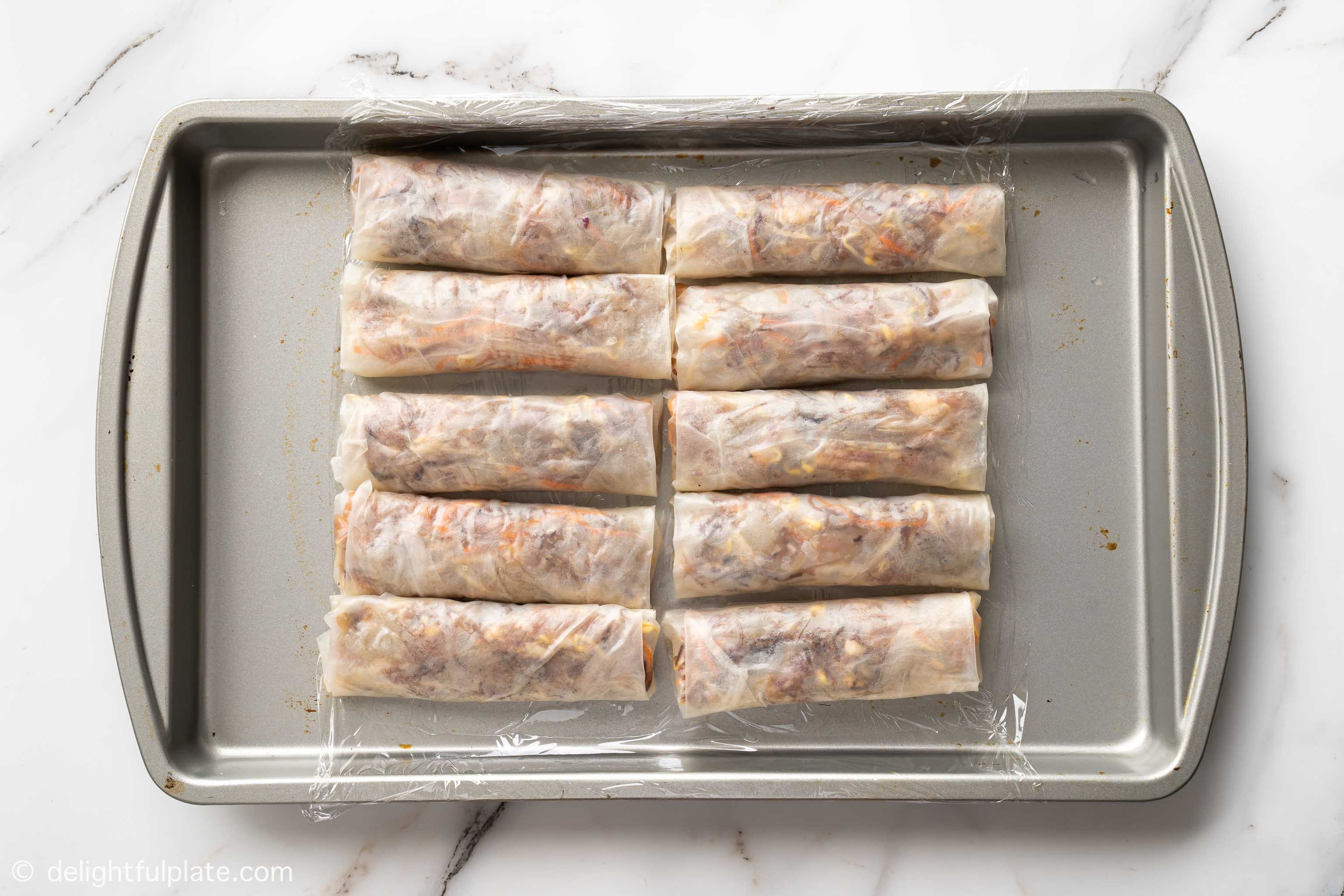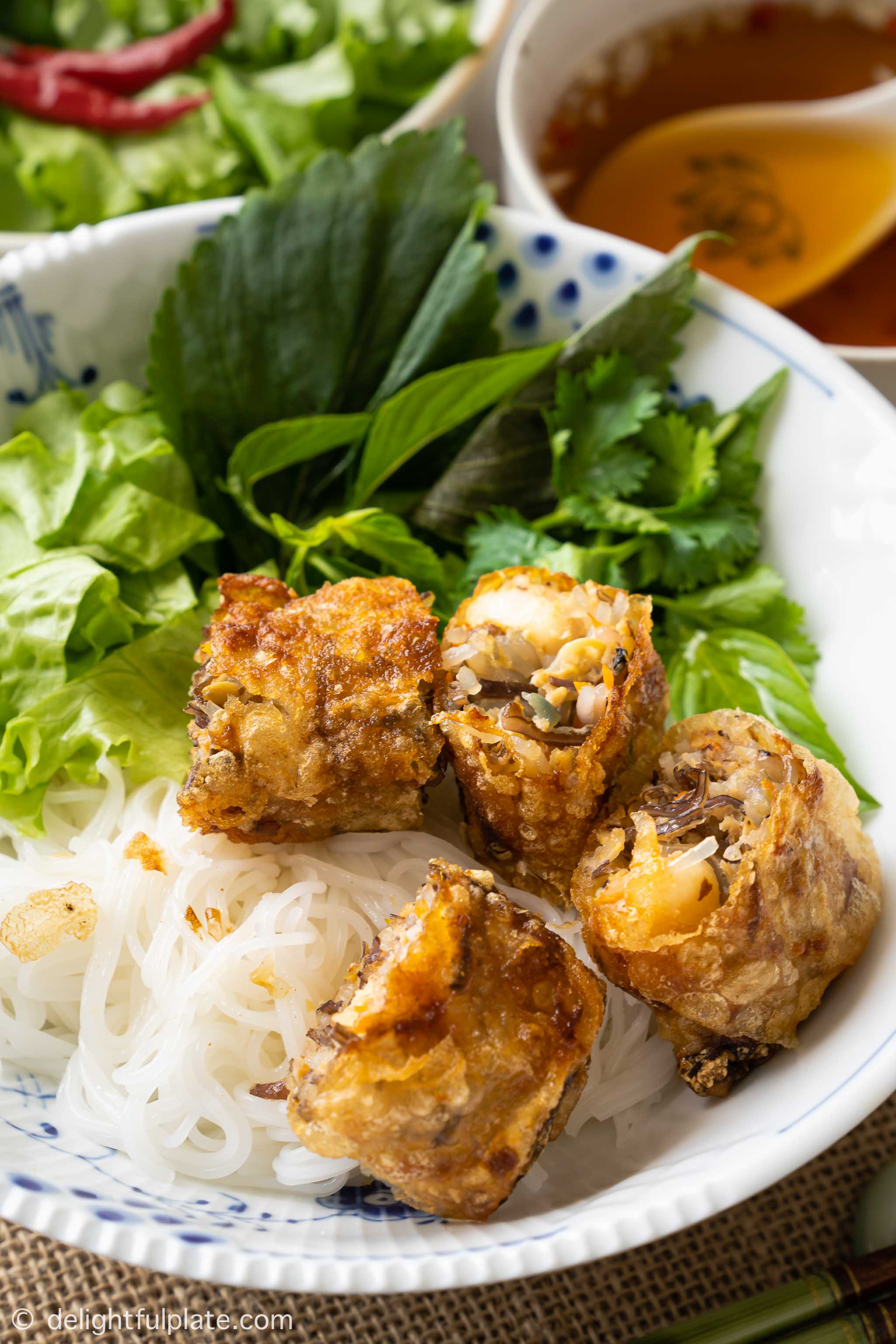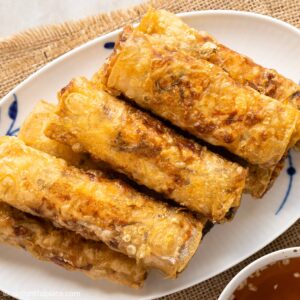Vietnamese Fried Spring Rolls Recipe Ground Beef
Vietnamese Fried Spring Rolls are delicious with crispy exterior and flavorful filling. This dish is a must in any traditional Vietnamese banquets or celebrations. I am sharing the authentic way to make them as well as tips to ensure they turn out golden and crispy.

What are Vietnamese Fried Spring Rolls
There are two main categories of spring rolls in Vietnam: the fresh ones (called gỏi cuốn) and the fried ones. Vietnamese people call the fried version nem rán (usually in Hanoi), chả nem (like in my hometown) or chả giò (in the South of Vietnam).
Depending on the regions, the filling may be slightly different, but it usually contains ground pork, shrimp, and a variety of shredded veggies. It is then wrapped with a spring roll wrapper and fried until golden and crispy.
Outside of Vietnam, some people call them egg rolls, but I personally avoid using those words to call Vietnamese fried spring rolls. I don't want to have an impression that they are made with egg roll wrappers which are not the same as the Vietnamese ones.
As mentioned at the beginning, this dish is a must in any Vietnamese traditional feasts or banquets. It is actually also great for everyday meal since you can make it ahead and freeze for later.
Watch How to Make these Crispy Spring Rolls
Subscribe to our Youtube channel for more easy-to-follow cooking videos!
Ingredients
The recipe I'm sharing today is an authentic Northern-style fried spring rolls. Here are the main ingredients:

- spring roll wrappers: these white sheets are made from rice flour and sun-dried before packaged and sold to consumers. In Vietnam, we don't use spring roll pastry or egg roll wrappers to make cha gio.
- ground pork and chopped shrimp: I often use a 50-50 or 60-40 ratio of pork to shrimp. When we have fresh crab meat on hand, I also love to add it to the filling.
- glass noodles (miến, also called cellophane noodles or mung bean thread noodles): you can find these at Asian grocery stores. Make sure you choose Vietnamese or Chinese glass noodles. The Korean ones are not suitable for this dish.
- dried wood-ear mushrooms: these add crunchiness to the filling.
- shredded carrot and beansprouts: these are among the most popular veggies used in spring roll filling. Some people like to use jicama or kohlrabi. When I was in the US., I sometimes took a shortcut by using a bag of slaw with pre-shredded cabbage and carrot :).
- eggs, shallot, fish sauce, salt and pepper
The Southern Vietnamese rolls have a slightly different filling. Instead of using glass noodles, people like to add shredded sweet potatoes or taro.

Cooking Notes
This dish is not difficult to make at all, although if you make a large batch, it can be quite time-consuming to wrap the rolls. First, you will need to slice or cut ingredients into small pieces and then mix them well to combine.
The next step will be wrapping. Use your fingertips to dab water over the wrapper to make it pliable, then add the filling and roll.

Here's a very important thing: when you make these Northern-style spring rolls, do not wrap too tight, or the rolls may burst when you fry them. The reason is the noodles in the filling will expand when frying.
One of the things that make this dish tasty is its crispy exterior. In order to achieve that, here are my family's tips:
- Add just a few drops of vinegar to the water you will use to dab over the spring roll wrappers
- Fry twice: first time with medium heat to cook the interior and second time to crisp up the exterior
- Use a generous amount of frying oil
- Fry the rolls in a single layer and leave some room to move them around. Overcrowding the pan will lower the heat too much and the rolls may not turn out crispy
How to Serve Fried Spring Rolls
It is best to eat the rolls right after the second fry. If you plan to eat them the next day, do the first fry, refrigerate them, and do the second fry the next day. If you want to freeze them for later, do so after the first fry.

The most common way to serve these is with rice vermicelli noodles, soft lettuce, fresh herbs and nuoc cham dressing. There is a variety of herbs you can use: cilantro, Thai basil, spearmint (peppermint is fine too), and perilla leaves.
In a traditional Vietnamese feast such as for Lunar New Year celebration, nem ran/cha gio is served with a selection of savory dishes, including poached chicken, sticky rice, soup and stir-fry. Here are other traditional dishes we like to serve in such feast:
-
Chicken Glass Noodle Soup (Mien Ga)
-
Xôi Gấc (Vietnamese Red Sticky Rice)
-
Vietnamese Crab Cellophane Noodles (Mien Xao Cua)
-
Vietnamese Square Sticky Rice Cake (Banh Chung)
I'd love to hear what you think about the dish, so please feel free to leave a comment and a rating if you have tried it. New recipes are added every week so let's connect on Facebook, Youtube, Pinterest and Instagram for the latest updates. You can find my collection of Vietnamese recipes here.

For the Spring Rolls
- 0.5-0.6 oz dried wood-ear mushrooms
- 1.75 oz dried glass noodles
- 9.5 oz raw peeled and deveined shrimp
- 10.5 oz ground pork
- 3.5 oz beansprouts
- 1.1 oz carrots, julienned
- 2 1/2 tablespoons minced shallots
- 1/2 teaspoon salt
- 1 1/2 teaspoons black pepper
- 1 teaspoon fish sauce
- 2 medium to large eggs
- 1 cup water
- 1/8 teaspoon rice vinegar
- 16-18 spring roll wrappers
- frying oil
To Serve
- rice vermicelli noodles
- soft lettuce
- fresh herbs such as cilantro, mint, Thai basil
- nuoc cham dressing (See Notes for suggestions on how to make it)
-
Soak dried wood-ear mushrooms in hot water for 5 minutes or until rehydrated, then julienne. Soak glass noodles in room-temperature for about 20 minutes. Once softened, cut noodles into shorter pieces, about 2-3 inch long.
-
Chop shrimps into smaller pieces but not too small. Place shrimp pieces and ground pork in a mixing bowl. Then add julienned wood-ear mushroom, beansprouts, carrot, glass noodles, shallots, salt, pepper and fish sauce. Give everything a quick mix. Then add 2 eggs and mix well to combine.
-
Before wrapping the rolls, you can fry a small piece of filling to see if it is seasoned to taste and adjust if needed.
-
To a small bowl, add about 1 cup of water and a few drops of rice vinege (about 1/8-3/16 teaspoon). Place a spring roll wrapper on a clean surface and use your fingertips to dab some water from the bowl to wet the wrapper.
-
Once the wrapper sheet is pliable, place about 2½ tablespoons of filling near the top part of the sheet. Form the filling into a log shape, then fold the left and right sides of the rice paper over the filling. Fold the top part of the sheet over and then roll it up away from you. Set aside. Continue to wrap until you have used up all the filling.
-
Place a frying pan over medium heat. Once the pan is hot, heat a generous amount of oil. When the oil is hot, add the spring rolls and fry in a single layer. You may need to increase the heat slightly after adding the rolls to ensure the oil is hot and bubbling (not too vigorously). Fry for 4-5 minutes until the outside is lightly golden, flip once or twice. Transfer to a wired rack or place on paper towel briefly to absorb excess oil.
-
Let the rolls cool down for 5-10 minutes. Then heat the oil again over medium heat and fry the rolls the second time. This time, use a slightly higher heat than the first time to crisp them up. Fry for 2-3 minutes until the outside is deep golden and crispy. Transfer to a wired rack or place on paper towel briefly to absorb excess oil before serving.
-
Serve right away with noodles, lettuce, fresh herbs and dressing.
Below is my suggestions for making the nuoc cham dressing:
- 1 cup (240ml) warm water
- 1 tablespoon granulated sugar
- 3 tablespoons fish sauce
- 2 tablespoons lime juice
- 2 teaspoons mince garlic
- bird's-eye chili, minced (optional)
- In a bowl, mix together water, sugar and fish sauce. Let it cool slightly then add lime juice. Taste and adjust to your liking. Then add garlic and chili.
Don't use ground pork that is too lean since it can be a little dry. When we have crab meat on hand, we like to swap some of the pork with crab meat.
Besides carrots and beansprouts, some people like to use jicama or kohlrabi in the filling. In the past, when I was short on time or needed to make a big batch, I sometimes took a shortcut by using a bag of slaw with pre-shredded cabbage and carrots.
Do not wrap too tight, or the rolls may burst when you fry them. The reason is the noodles in the filling will expand when frying.
Make sure you fry the rolls in a single layer and leave some room to move them around. Overcrowding the pan will lower the heat too much and the rolls will not turn out crispy.
Calories: 587 kcal | Carbohydrates: 61 g | Protein: 38 g | Fat: 20 g | Saturated Fat: 7 g | Trans Fat: 1 g | Cholesterol: 312 mg | Sodium: 1452 mg | Potassium: 513 mg | Fiber: 3 g | Sugar: 2 g | Vitamin A: 1447 IU | Vitamin C: 8 mg | Calcium: 174 mg | Iron: 6 mg
Comment & Rate below or Tag @delightfulplate on Instagram
Source: https://delightfulplate.com/vietnamese-fried-spring-rolls/
0 Response to "Vietnamese Fried Spring Rolls Recipe Ground Beef"
Post a Comment